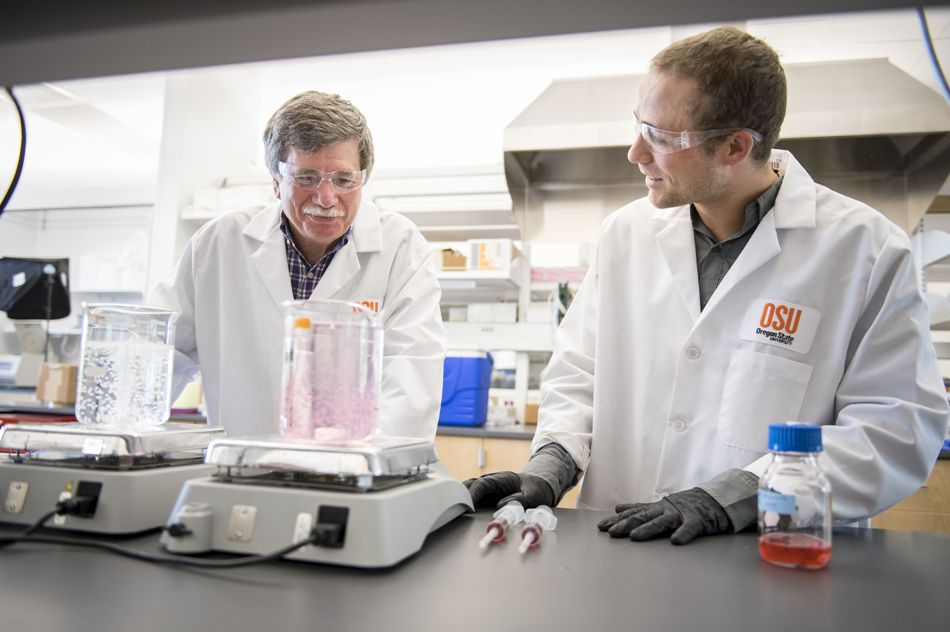Mar 26 2020
According to a study performed by Oregon State University, beads containing bacteria and a slow-release food supply to sustain them can be used to clean up contaminated groundwater for several months continuously without the need for maintenance.
 Hydrogen beads. Image Credit: Oregon State University.
Hydrogen beads. Image Credit: Oregon State University.
The hydrogel beads, which have a gummy candy consistency and produced with an ingredient utilized in processed foods, could enable continuous cleanup of groundwater contaminated with unsafe and extensively used volatile organic compounds; the Centers for Disease Control and Prevention has listed a majority of the compounds as potential human carcinogens.
The concentrations of chemicals present at many locations across the country greatly exceed federal and state standards for safe drinking water.
Among the contaminants dealt with in the research are cis-1,2-dichloroethene, 1,1,1-trichloroethane, and 1,4-dioxane—degreasers that are generally used by the military and industry. The chemicals can penetrate groundwater via leaky underground runoff or storage tanks, or by simply being thrown on the ground as they were done earlier.
The latest decontamination technique, created through a partnership between North Carolina State University and the OSU College of Engineering, is effective because an enzyme produced by the microorganisms oxidizes the toxins when groundwater contaminants diffuse into the beads. This ultimately changes the contaminants into harmless compounds.
We’ve created a process called long-term aerobic cometabolism, which is an enclosed, passive, self-sustaining system for groundwater remediation. The beauty of this is that everything happens inside the beads.
Lew Semprini, Study Principal Investigator and Distinguished Professor of Environmental Engineering, Oregon State University
Semprini explained that present practices demand gaseous growth substrates such as methane and propane to be incorporated directly into the subsurface. The substrates sustain indigenous pathogens, which consequently yield enzymes that change the pollutants into harmless byproducts.
But most often, the growth substrates chemically contend for those vital enzymes, which considerably hinder the transformation process. That competition is now eliminated by the new system, which enables the entire enzyme to oxidize contaminants.
We’ve flipped the paradigm on its head by putting the right microorganism inside hydrogel beads and supplying it with a slow-release food source. To my knowledge, this is the first time it’s been done.
Lew Semprini, Study Principal Investigator and Distinguished Professor of Environmental Engineering, Oregon State University
The research paper was published in Environmental Science: Processes & Impacts.
Along with his research team, Semprini co-compressed the bacteria culture Rhodococcus rhodochrous as well as a slow-release growth substrate inside the hydrogel beads that were created by them in the laboratory. The cylindrical beads, composed of gellan gum—a typical ingredient used in processed foods—measure 2 m in length.
When groundwater flows by the hydrogel beads, the contaminants present in this groundwater diffuse into the beads, where the slow-release substrate reacts with groundwater to create alcohol that nourishes the Rhodococcus bacteria.
A monooxygenase enzyme in the bacteria changes the contaminants into innocuous compounds, such as chloride ions, water, and carbon dioxide. The purified water as well as the byproducts subsequently diffuse out of the beads and recombine with the groundwater plume.
In bead-filled test columns that are provided with a continuous flow of contaminated water, the system worked continuously for over 300 days (and counting) on the novel growth substrate.
Semprini learned that the beads eliminate over 99% of the contaminants, and their concentrations dropped from more than a few hundred parts per billion to less than 1 part per billion.
The longevity of the system will largely rely on the duration of the survival of the pathogens, which is a factor of how long the growth substrate lasts. That has not been established yet.
“It’s a question for future research,” Semprini added. “How do we make beads that last many years, or how do we develop systems that can easily be replaced?”
Existing cometabolic remediation techniques necessitate regular incorporations of growth substrates to make sure that main pathogens thrive, and that requires biochemical modifications, routine site monitoring, and associated costs.
The next step is to expand the system and perform pilot studies in the field.
Semprini predicts numerous possibilities for arranging the beads. One choice is to mix beads directly into unclean subsurface material; the second is to dig a ditch in the path of groundwater flow and add beads into it, forming a permeable reactive barrier; and a third choice is to pack beads into reactors, a basic form being mesh bags, that can be put in wells.
Everybody favors sustainability in this type of system: Can we just have something working in the subsurface without much maintenance? I think we’ve achieved that.
Lew Semprini, Study Principal Investigator and Distinguished Professor of Environmental Engineering, Oregon State University
The Department of Defense funded this study.